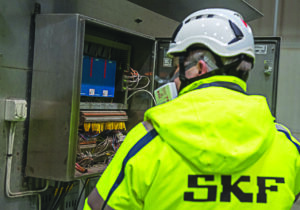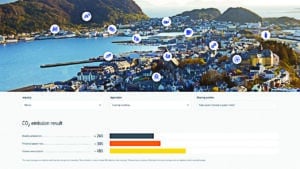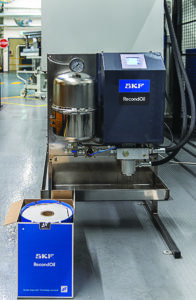SKF is using IMARC 2023 as an opportunity to promote a sustainable and circular economy.
SKF has built its reputation on developing, designing and manufacturing state-of-the-art bearings, seals and lubrication systems.
With products found in almost every corner of the global mining industry, SKF takes the responsibility of leading its customers toward a more sustainable future very seriously.
Circular economy
Sustainability, carbon emissions and the push for net-zero are becoming increasingly important for companies within the resources sector.
But there is still a reliance on a take-make-waste cycle, whereby resources are taken from the ground, used in products and then discarded at the end of their usage.
SKF is looking to change this long-entrenched approach with a forward-leaning and ambitious new purpose statement, ‘Together, we re-imagine rotation for a better tomorrow’.

This statement directly amplifies the company’s stance on a circular economy, with commitment to creating intelligent and clean solutions for people and the planet.
“We look at a circular economy through a lifecycle lens,” SKF principal application engineer Dario Rodriguez told Australian Mining.
“A total of 20 per cent of all energy used in the world is wasted in overcoming friction. Our main focus is to minimise that waste.
“Once we have designed a bearing arrangement for an asset and we’re learning how it’s performing out in the field, then we can feed those learnings back into the design phase and improve our product even further.
“This allows us to both improve asset life and use less energy.”
Through in-depth analysis during the design (eg right bearing, right lubricant type and amount, right sealing system, etc) and usage phase (eg proper installation, correct alignment, optimal settings, etc), SKF can achieve additional reductions in friction. This means power losses are minimised, energy consumption is further reduced, which in turn reduces CO2 emissions.
SKF is committed to reducing energy consumption across the entire manufacturing value chain, a mindset the company has embedded throughout its operations.
“We aim to be net-zero from our own operations by 2030,” Rodriguez said.
“We have several initiatives and programs in our factories looking to improve our processes to reduce energy consumption and have even celebrated the milestones of having several factories energy-neutral.
“That means several of our factories are operating solely on green energy supplied by solar and wind for all their production requirements.”
Bearing Select software
With its strong sustainability profile, SKF is well-placed to deliver new technological advancements in a move toward net-zero.
SKF Bearing Select software is a free-to-use application that allows customers to explore how choosing bearing arrangements that minimise friction and reduce lubricant consumption can have a significant effect on their CO2 footprint.
“The reports can be used to illustrate how emissions can differ in various configurations for the same application,” Rodriguez said.
“You can look at any machine in the mining process and they will all have different technical alternatives. For example, some use grease lubrication, some use oil, and so on.
“Users can add these data points in Bearing Select and get a better understanding on CO2 emissions.”

The Bearing Select software also allows users to engage directly with SKF’s application engineers, who can provide a more detailed view on specific emissions from the bearing.
“It’s one of the best tools to use for regular technical evaluation of different bearing solutions,” Rodriguez said.
“Whenever we are involved in advising the manufacturer or equipment end user what the best technical options are, we can use this software to illustrate our options.”
SKF is using the Bearing Select technology in combination with its ability to remanufacture bearings to get even more out of the life of a product.
“Remanufacturing gives us the opportunity to inspect the bearing at the right time and do the rework it needs so it can go back in operation with a full second life,” Rodriguez said.
“Depending on the amount of work needed, a remanufactured bearing reduces the carbon footprint by up to 90 per cent compared to a new one.”
IMARC
The 2023 International Mining and Resources Conference (IMARC) will see SKF promote sustainable rotation and showcase how the company can help its customers move towards a circular economy.
“Remanufacturing contributes to reducing lifecycle costs of many critical assets, and at the same time reduces environmental impact,” Rodriguez said. “(Remanufacturing) is going to be one important element that we’re going to showcase at IMARC, but another one is SKF’s RecondOil – a truly circular use of oil.”
RecondOil technology allows for cleaner oil without having to change it. By re-using the same oil, customers can enjoy more sustainable operations.

“The ideal solution for our customer is extending as much as possible the performance of their machines,” Rodriguez said. “IMARC attendees will see how our condition monitoring solutions not only help to predict and alert about premature failures but let us learn more about why assets fail. We use that knowledge to develop the next generation of products.”
One such solution is SKF’s On-Demand Lubrication system, which combines predictive maintenance with lubrication automation, resulting in a system that modifies its cycle according to the bearing condition.
“We were asking ourselves, how do you optimise the usage of lubrication rather than just using it and letting it go to waste?” Rodriguez said.
“How can we make sure that our customers’ equipment is working correctly, so they can have it running for as long as possible, with minimal lubrication, with minimal energy consumption, and with the lowest environmental impact?
“So that’s the end goal that we are aiming for.”
This feature appeared in the October 2023 issue of Australian Mining.




